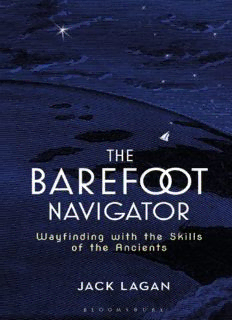
The Barefoot Navigator: Wayfinding with the Skills of the Ancients PDF
Preview The Barefoot Navigator: Wayfinding with the Skills of the Ancients
CONTENTS Conventions and Credits Foreword to the New Edition A Short Lexicon A Barefoot Philosophy for the 21st Century GPS: The Death of Navigation? A Strategy for the Future PART 1: THE REMARKABLE SKILLS OF THE ANCIENTS The Pacific Islanders Just Another Day in Paradise? Tangata: The Gods of Navigation Feelers of the Sea The Chart in Captain William Bligh’s Head Tupaia’s Chart Strategies and Tactics The Vikings The Ring of Bears The Norse Sagas as Cruising Guides The Polar Stick Sol-Skuggjáfjøl: The Sun-Shadow Board The Uunartoq Compass The Viking Sunstone The Mediterranean: Pharaohs, Phoenicians and Greeks Queen Hatshepsut’s Shopping Trip The Thalassocracy of Phoenicia King Necho II’s Big Adventure Lateen Rigs and Wind Compasses The Arabs Ships of the Desert at Sea The Rahmāni, the Kamal and the Akhdh al-Kawakib The Chinese Sampans and Junk History Longitude Chinese-style The South-Pointing Needle Renaissance Navigation Portolan Charts and Some Very Rum Lines Dividing Circles: The Search for Accuracy PART 2: PRACTICAL NO-TECH NAVIGATION Which Heading? Horizon Events The Sun Rising Setting The Trade Winds The Movement of the Sea The Waves The Swell Surface Currents Tidal Currents Catch a Rising Star: Barefoot Astronavigation Star Trains: Stations and Schedules Above the Horizon The Hand of Kaho’s Apprentice: Measuring Angles The Big Picture Astronomical Mythography and Aids to Pattern Recognition Looking North: Finding Polaris Star Trains: The Merak Express Looking South: Finding South Using Crux Star Trains: The Canopus Commuter Star Trains: The Scorpius Special Looking East and West: Hunting with Orion Orion’s Helpful Neighbours The Latecomer to the Party: Spica Stranger in the Dark: Fomalhaut 360 Degrees of Separation: Introducing the Pelorus The Sidereal Compass Where Am I, Roughly? Latitude: A Belated Definition Zenith Stars Using Polaris to Estimate Latitude Give Me a Little Latitude: A Navigation Strategy Landfall The Clouds The Birds Reflected and Refracted Swells The Wind: Land and Sea Breezes The Water Aircraft Ferries and Other Sea Traffic Radio Masts PART 3: DO-IT-YOURSELF LO-TECH NAVIGATION Dead Reckoning Improvising a Magnetic Compass The Watch Compass Calculating Speed: The Home-Brew Log Line Calculating Speed: The Dutchman’s Log The Traverse Board: Logging Your Dead Reckoning The Pelorus: Non-Magnetic Steering Compasses Steering: The Sun Compass Steering: The Star Compass Steering: The Superlorus Latitude Kamals and Polar Sticks The Astrolabe, the Cross-staff and the Backstaff Improvising Quadrants Latitude Using the Sun at Noon Latitude Using the Stars Making a Sun-Shadow Board Longitude The Ubiquitous Quartz Watch Using the Sun at Noon Using a Compass Longitude by Polar Stick A Minimalist Longitude using Kochab A Combined Declination/EoT Table Latitude, Longitude and Lunar Distances Plumbing the Depths PART 4: SURVIVAL NAVIGATION Be Prepared The Grab Bag Stranded Ashore? Aft Word to Second Edition Recommended Further Reading Timeline of Navigation and Exploration Appendices Notes Index CONVENTIONS AND CREDITS Distances: In general terms, distances are given in kilometres, except where a distance is given in statute miles within a quotation. In those cases, a metric equivalent is provided. Navigation distances: When discussing navigation at sea, distances are given in nautical miles (nm) for the simple reason that it is the only measure that derives from the geometry of the Earth. One nautical mile = one-sixtieth of one degree of latitude and is approximately 1.2 statute miles. A ‘knot’ is not a distance but a speed: one nautical mile per hour. That’s the way it has to be. Measurements: Measurements are in the metric system, although I may occasionally slip in feet when giving the length overall of a boat. Dates: Historical dates are quoted using the new convention. ‘AD’ is now ‘CE’ (Common Era) and ‘BC’ is ‘BCE’ (Before Common Era). Specific dates are expressed as day-month-year, with the month spelled out to avoid confusion (eg, ‘11 July 2017’. I may occasionally refer to a date as ‘July 11’ when an entry is to be found in a table and the month comes first. Time: Greenwich Mean Time (GMT) is now referred to as Universal Time (UT) or Universal Time Corrected (UTC). But it is also sometimes referred to as ‘World Time’, and by the military as ‘Zulu Time’. I quite like the sound of ‘World Time’, but will use UTC and GMT in this book. Actual times are shown as four digits, without punctuation and always using the 24-hour clock. Maps: Unless otherwise sourced, the maps were produced using Map Maker Pro, available from www.mapmaker.com. Star charts: Images of the night sky were created using Patrick Chevalley’s Cartes du Ciel software (available from www.ap-i.net/skychart) and Stellarium
Description: